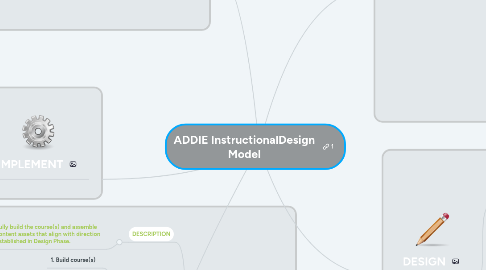
1. DEVELOP
1.1. DESCRIPTION
1.1.1. Fully build the course(s) and assemble content assets that align with direction established in Design Phase.
1.2. ACTION STEPS
1.2.1. 1. Build course(s)
1.2.2. 2. Consider application of graphics, colors, fonts, and other types of media that will increase course engagement.
1.2.3. 3. Evaluate course navigation as it is being developed. How will these decisions impact the learning experience?
1.2.4. 4. Pilot test course
1.2.4.1. Systematically check accuracy of content and functionality of navigation
1.2.4.2. Review pilot with SMEs
1.2.4.3. Get feedback and make adjustments as needed
1.2.5. 5. As needed, develop training material for facilitator/ instructor and/or learners
2. IMPLEMENT
2.1. DESCRIPTION
2.1.1. Share course(s) with the learner
2.2. ACTION STEPS
2.2.1. 1. Prepare learning space
2.2.2. 2. Monitor the course and learner's engagement
2.2.3. 3. As needed, support facilitator/instructor with working in the learning environment.
3. EVALUATE
3.1. DESCRIPTION
3.1.1. Formative assessment is an iterative cycle occurring between the first 4 phases of the ADDIE model. Summative assessment happens at the conclusion of the course to evaluate the quality of the learning and the degree to which it accomplished the instruction goals/learning objectives.
3.2. ACTION STEPS
3.2.1. 1. Conduct formative assessments
3.2.1.1. Are we meeting the goals?
3.2.1.2. Have we identified other training requirements?
3.2.1.3. Do we need to adjust the learning experience...navigation, media types, content chunking, etc...?
3.2.2. 2. Conduct summative assessment
3.2.2.1. Review learner responses to surveys and/or tests
3.2.2.1.1. Was learner satisfied with the experience?
3.2.2.1.2. Did the learner acquire the new knowledge and/or skills?
3.2.2.1.3. Can the learner apply what they learned?
4. ANALYZE
4.1. DESCRIPTION
4.1.1. Audit current situation to better understand goals, learning environment, instructional problem, learners' knowledge gaps, previous training methods and designs, and media preferences.
4.2. ACTION STEPS
4.2.1. 1. Interview SMEs
4.2.1.1. Who are the learners?
4.2.1.2. What are the learners' behaviors and feelings around training?
4.2.1.3. What is the new behavior you would like to see as a result of building this training?
4.2.1.4. What are the learning constraints?
4.2.1.5. What are the options for delivering the training? How would you like learners to experience training?
4.2.1.6. What are the learning theory considerations?
4.2.1.7. Are there any brand standards that need to be incorporated?
4.2.1.8. What is the timeline?
4.2.1.9. What is the budget?
4.2.2. 2. Begin thinking about how learning will be evaluated to create alignment with learning objectives.
4.2.3. 3. Create Training Plan
5. DESIGN
5.1. DESCRIPTION
5.1.1. Use Training Plan to define specific and measurable learning objectives. Strategically create learning experience that 1. ) connects content, learning objectives, and assessment, and 2.) serves up content in a logical sequence to support learner's construction of knowledge.
5.2. ACTION STEPS
5.2.1. 1. Storyboard the learning experience
5.2.1.1. Review storyboard with SMEs
5.2.1.2. Get feedback and make adjustments as needed
5.2.2. 2. Create the prototype
5.2.2.1. Review prototype with SMEs
5.2.2.2. Get feedback and make adjustments as needed
